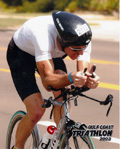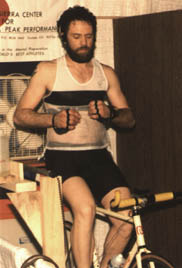|
Coach Ralph Frazier
My Cycling History

The credit for my involvement in
cycling goes to my brother-in-law, Skip Pitzer. Skip is married to
my older sister Joanne. He is my original mentor.
Skip's interest in athletics
started at an early age. While in high school and college in the
60's, Skip was a track and football star. Skip started road cycling
in 1970 and he soon became seriously addicted to it. In 1971, he and
his buddy, Dave Pfeiffer, rode their 30-something-pound Schwinn
Continental "water buffalos" from Springfield, Ohio to my parents'
home near Cumberland, Ohio - a distance of over 130 miles! Dave was
wiped out, but Skip was ecstatic! Skip had the ultra-distance
cycling bug.
Similar to Skip, my participation
in athletics began in high school. I ran cross-country, track, and I
was a member of the basketball team. Skip had a definite influence
on me. By my sophomore year, I concentrated on track. I was captain
of my high school track team my junior and senior years.
As a teenager, I routinely visited
Joanne and Skip for a week each summer. While visiting in August
1973, I was 17 years old and I was saving money to buy a car. Skip
stepped in and changed my direction. He convinced me to buy a bike
instead of a car. That is how I got the disease.
Skip helped me select my first
bike. I purchased it from the Kettering Pro Bike Shop in Kettering,
Ohio, a suburb of Dayton.
1973 C Itoh (Bridgestone) 23"
steel frameset, orange, Sugino Crank 52/42, SunTour derailleurs,
SunTour downtube friction shifters, including a SunTour
Freewheel 13-21 5-speed, KKT rat-trap pedals with Christophe toe
clips and Binda straps, 27" Sun steel rims with 1 1/8" clincher
tires, Dia-Compe center-pull brakes, Sakae Royal Road Champion
40-cm handlebars, Sakae Royal quill stem, Sakae Royal
27.2-seat-post, Seamless BS Saddle - Total price was $199.
After I bought the bike, Skip
taught me how to ride, crash, stop, draft, etc. - in that order!
Just one week after buying the bike, Skip and I rode from his home
in Springfield to my home near Cumberland, Ohio - a total distance
of 133 miles. I survived that ride and my obsession has advanced
beyond recovery for the past 29 years!
Here are examples of
how my passion for cycling grew.
Between 1973 and 1983, I had ridden
132 centuries. Most of these rides were with Skip. Among these rides
were our one-day trips across Ohio. In my college days, Skip and I
rode 266 miles across Ohio from the state border near Richmond,
Indiana, to the Ohio River at Steubenville, Ohio. Later in 1980, we
rode the Cardinal Trail Ride (312 miles) in one day. Clearly, I had
a passion for long distance cycling.
In addition to my extensive road cycling mileage, I spent
countless hours riding my rollers during the winter months. Several
times I had ridden more than 100 miles during weekend afternoons
while watching college basketball on my TV set.
My passion advanced to where I became focused on the
ultra-marathons. On April 15, 1983, I participated in a 24-hour
roller race, which was held at the local shopping mall in
Zanesville, Ohio. The other participants were Bob Schmelzle, Glen
Button, Herb Fitzer. This roller "marathon" race was an exhibition
to advertise cycling and the Wheel & Spoke Bike Shop in Zanesville.
Bob Schmelzle was an ultra-marathon
cycling celebrity - he originated BAM, Bicycle Across Missouri in
the 70's. Glen Button was a local racer who worked at the Wheel &
Spoke. Herb Fitzer was a former Michigan State track star who began
cycling after his graduation.
The event started promptly at 6
p.m. Bob rode furiously, while the rest of us rode at a controlled
pace. I watched Bob's dial spin and he lapped me several times as
the first hours passed. By 4 a.m., Bob was 17 miles ahead, but I
noticed that he was slowing. By that point, his pace only matched
mine.
At 9 a.m. either fatigue, or
monotony, or perhaps a combination overcame Glen Button. He
abandoned the race and finished in third place with 355 miles. At
the same time, Bob was noticeably suffering. He sent one of his
supporters to ask my support crew when I was planning to take a
break. I had previously informed my crew that I did not plan on
stopping. They relayed this information to Bob's support person, who
in turn told Bob. Within a half-hour Bob dismounted for a short
massage. He was still leading me by 15 miles. After briefly
remounting, Bob dismounted again for a longer duration. I trailed by
less than eight miles. Bob remounted and rode for less than five
minutes, then he dismounted for a two hour nap. By the finish at 6
p.m. Saturday evening, I had recorded 521 miles -- first place! Bob
was second with 485 miles.
More marathons.
As the middle of 1986 rolled
around, I was totally consumed by the cycling ultra-marathon bug. By
that point in my career, I had completed 288 centuries, including 16
double centuries, two triple centuries, and one quad century. So in
1986, I entered two 24-hour road cycling marathons. On June 6, 1986,
I rode the "Central Quad Century" and on July 12, 1986, I rode the
Bicycle Marathon of Columbus.
Since the 24-hour roller race three
years earlier, Bob Schmelzle had become my frequent ultra-marathon
cycling partner. He introduced me to the world of the ultra-distance
competition. One of Bob's favorite events was the Central Quad
Century (Litchfield, Illinois). He arranged for me to join as a
member of his four-man ultra-marathon team. The team included Bob,
two of his Saint Louis-native ultra cycling buddies, a four-man
support crew, and me. A Saint Louis bike shop provided the support
crew and van. Our goal was to have all four team members log at
least 400 miles.
Central Quad Century (CQC) -
June 6, 1986
The Central Quad Century route consisted of a 161-mile day-loop
and a 20-mile night-loop. The day-loop had a 15-hour time limit,
that is, all riders had to return to the check-in station at the
start-finish line by 9 p.m. After completing the day-loop, the
cyclists would start riding the night-loop. As each night-loop was
completed, the cyclist would report to the check-in station where
the official mileage was recorded. The cyclist would repeat the
night-loop until the 24-hour mark or the retirement from the event.
A few minutes before 6 a.m., our
team gathered with about 500 other cyclists to receive final
instructions from the officials. Following final instructions from
the event officials, the starting pistol sounded. The first few
miles were very fast. The elite cyclists tried to shake the
pretenders. Our team managed to stay near the front. The lead pack
was pulling us along between 25 and 30 mph. Our crew drove ahead to
the first feed-zone (35 miles). The crews were not allowed to
provide support until after the first feed-zone. Everything was
fine; I was comfortable within the pack. That all changed at the
first feed zone!
There was one crewman for each of
our cyclists. As we slowed through the feed-zone, our corresponding
crewman handed a feed bag to us, which we grabbed as we passed. The
situation is sort of chaotic - cyclists and support crewman mixed,
reaching and grabbing. As I reached for my feed bag, the cyclist in
front of me abruptly applied his brakes. The next thing I knew, I
was skidding on the rough pavement. The pack flew on! Within a few
seconds, my crew was at my side. I had a good deal of road rash, but
the most serious injury was a deep cut in the knuckle of my
right-hand middle finger. The flesh was laid open exposing the bone!
One crewman dumped peroxide on my wound and wrapped the finger in
gauze. The bandage wouldn't hold, so I put on my cycling glove to
hold the dressing and flesh in place. By the time I remounted my
bike, the pack was long gone! As I rolled forward, my support crew
informed me that I was on my own, they had to catch the pack to help
my teammates!
Furiously, I pedaled my bike. My
anger gave me a boost. I passed several victims of the lead pack's
speed. By the second feed-zone, 75 miles, I intercepted my support
crew. They had just finished their duties at the zone and they were
preparing to follow the pack. They told me that I had closed within
30 seconds. But I was hammered! I resigned to the fact that I would
not be able to catch the big group. Consequently, I rode alone for
another eleven hours; occasionally passing riders whom had been
dropped by the lead pack.
As my first teammate completed the
day-loop, our crew changed their duties. While two of our crewmen
patrolled the night-loop in the van, the other two stationed
themselves near the check-in station. I was the last teammate to
complete the day-loop. A few minutes before 2 p.m., I finished the
day-loop and received food and drink from our crew.
Somewhere on my eighth night-loop
and having covered over 300 miles, I caught and dropped Bob and
teammate #2. Around 2 a.m., I caught teammate #3. We rode together
for about an hour, then he stopped to rest at the check-in station.
I was completed my twelfth 20-mile night loop just before 5 a.m. My
mileage total was 401 in 22 hours 47 minutes - I still have the
certificate! With only a little more that an hour remaining and
while I was at the check-in station, one of our crewmen informed me
that my three teammates had stopped for a food break and they had
decided to wait for me to arrive. Bob and teammate #2 had 381 miles
and teammate #3 had 391. They were tired. I appeared to be
relatively strong. There remained enough time for everyone to get
400 miles as long as I would pull my three teammates another 20-mile
loop! I was delighted to serve my team!
As dawn brightened the skies, I pulled the team around the final
lap. We reached the check-in station with three minutes to spare.
Consequently, Bob and teammate #2 tallied 401 miles, teammate #3
logged 410 miles, and I managed 421, which was good enough for
fourth place overall. Our team was the only one that every member
logged 400 miles or more.
By the way, Jim Amelung won the
event with an incredible 498 miles.
Bicycle Marathon of Columbus
(BMOC) - July 12, 1986
The
Bicycle Marathon of Columbus was held
five weeks after the Central Quad Century. Again, Bob and I entered
the event. My intent was to break the Ohio 24-hour record of 360
miles held by Rick Gunther from Toledo, Ohio. As a side note,
Rick held the 24-hour World Roller Record, 838.70 miles, May 14,
1983, and the World Tandem Roller Record with Kevin Hayes, 655.63
miles, March 31, 1984.
|

Rick Gunther training on rollers |
The Bicycle Marathon of Columbus, BMOC, course consisted of a
161-mile day loop with two night-loop options: a 20-mile and a
7.5-mile loop. The check-in points were located at the 80-mile mark
and the start-finish line.
This time, my support crew on crew was the greatest on Earth! It
consisted of my sisters, Joanne and Becky, my stepsister Carol Jean
Collins, my coach, Frank Booth, and my doctor/brother-in-law, Steve
Connelly! They followed me the entire day in my car. They made
switches after the day-loop and tow different times at the check-in
station during the night-loops. Needless to say, I was never
abandoned!
|
|